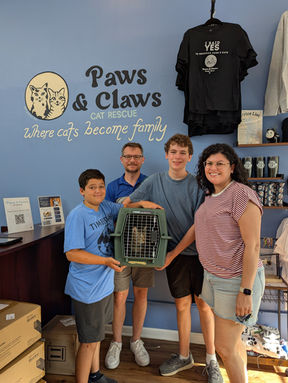
RESCUE:
not just a verb, it's a promise.
POST ADOPTION SUPPORT
We are here for you even after you adopt. We are happy to talk you through any challenges you are facing with your newly-adopted animal and to brainstorm ideas to make your new pet more comfortable in their new home. And, of course, we always love to chat and hear how your new cat is doing. We encourage adopters to review the resources provided post-adoption for more guidance, especially at times when we are unreachable. If you and your new pet aren't a good fit, we will always take our felines back and ask that you contact us right away.
* Please note: updates from you are required and are a part of the adoption process.
RETURN POLICY
We will always, always take our animals back. If you are in a position where you can no longer care for your adopted pet please email info@pawsandclawscatrescue.org with "Return of Paws and Claws Animal" in the subject or call us. We ask that Paws and Claws alum are returned to us and not rehomed or surrendered elsewhere.
RESOURCES
Bringing a new cat home is always an adjustment, both for you and your new companion. We’re here to support you every step of the way, whether through answering your questions directly, connecting you with the resources available in our post-adoption support on Petszel, or guiding you to trusted tools like this WhiskerWiki. This comprehensive resource covers just about everything you might need to know as you and your cat settle in together.
ADOPTION LOVE STORIES
Each adoption story highlights how our community's love and compassion has led to countless happy endings. We'd love to hear about your love story and post them for others to enjoy!
INTEGRATION
We recommend a two-week slow integration into your home. Your newly adopted cat will be nervous and will need some time to adjust. Please give your new feline a special place to get acclimated, where they feel safe and are far away from other pets and small children.
Cats should be confined to a room with their litter box, food, and water. This will become the cat’s home base. When they are allowed to begin exploring the rest of the home for short periods of time, they will know where to return to use their litter box. If there are other pets in the home we recommend scent swapping; a bed or blanket from your resident pet should be put in the room with the new cat and vice versa.
Here is a detailed resource on cat-to-cat intros. To summarize:
-
Your new pet should be kept in a spare room (bathroom, bedroom etc) away from other pets
-
You will provide items to the new pet such as bedding and toys that smell like current pets and vice versa allowing the animals to acclimate to each others scent before meeting
-
Feed pets on either side of a close door so they begin to associate something positive (food) with the other cats presence
-
Put up a screen, baby gate or dog gate so the animals can see each other but not approach
-
Start short meet and greets for 5-10 minutes at a time and slowly extend the time if things go well
-
Continue to supervise and close the new pet in their space when you are not around until fully confident everyone is getting along




















